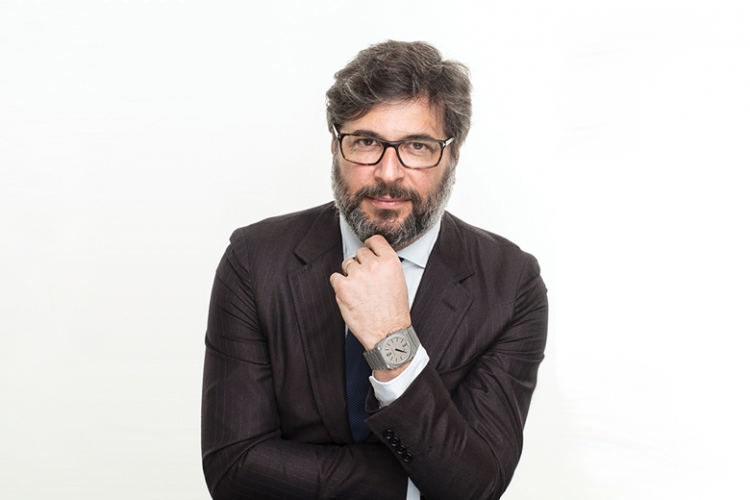Simple complications from Bvlgari
Bvlgari Octo Finissimo Automatic
This year, Bvlgari has unveiled watches for men and women that are showstoppers in their own right and so we have the Octo Finissimo Automatic – a triple record breaker – and the customisable Serpent Skin for women. Guido Terreni – Head of Watches at Bvlgari – talks to “Day & Night” on the inside workings of the marque
Tell us about the Octo Finissimo Automatic?
We started developing the Finissimo in 2011 and it saw the light in 2014 with the thinnest tourbillon in the world at 1.95 mm. In 2016, we coupled it with the thinnest minute repeater in the world. Obviously, these two are record breakers – very expensive and exclusive timepieces. The idea was to give gentlemen an ultra-thin watch with modern aesthetics that men can wear daily – an everyday indulgence rather than only on special occasions.
We needed an automatic movement for this because an automatic works for everyday use. It took a long time to develop this movement, around six years, because we had to master the ultra-thin technique as it is not a small limited edition of 50 or 70 but an on-going collection.

How did you make the ultra-thin movement? Is it done on the plate of the watch itself?
The movement is the thinnest automatic one in the world and it is done with a micro-rotor integrated into the movement. So we are talking about 2.23 mm with a platinum micro-rotor – it is the heaviest material and therefore, we use it in a small micro-rotor to charge a barrel that stores 60 hours of power reserve.
If the micro-rotor weighs so less, it might not rotate so much?
The smaller the rotor, the less strength you have. We started from a 4Hz development; halfway down the road, we understood that 4Hz was generating too much frequency and giving too much energy. We then passed to 3Hz and we had to develop a new escapement for the 3Hz and this enabled us to win the energetic balance, because to charge a movement automatically with a rotor, you need to charge it two-and-half times of what you are consuming when awake as you have to cover the night. Because when you are sleeping, your watch is not charging as it is on your nightstand. To do so, we struggled to find a balance but we were able to do that and now it is very reliable.

Is this movement powerful enough to be used as a base movement on which modules can be added later?
It has sufficient torque but the aim is to be thin, so if you are adding to it you are increasing the thickness. We already have a base calibre that is powerful, has a big torque, is 3.7, and it does not make a difference if you are adding 1.5 mm. Plus, it is a very expensive movement compared to a simple three-hand watch movement. Through the back case you can see that the movement is wide – 40 mm, in keeping with today’s standards. We wanted to keep out the formality and make it a contemporary style. That is why we have used sun-blasted titanium as a material, one that we had already used in the Minute Repeater and which had impressed the industry with its beauty and technique. So we had this very pure, very clean aesthetics with a sun-blasted case, dial, and bracelet.
Are you capable of mass-producing the movement?
We are not a mass-producing brand; if you are thinking of 1,000 pieces or more, then yes. That is why the price point of this watch is €12,500.
Q: How is that you are able to offer the strap and the bracelet versions with such a small price difference as € 1,000, when titanium is such a difficult material to work with?
That depends on how well the tunings are done as that is pretty important in titanium. Of course, titanium wears out tunings much faster than steel because titanium is harder, but we managed to keep the costs quite low. You cannot add too much, i.e., more than €1,000 for a titanium bracelet because that is the customer’s perception of how much it costs for a metal bracelet. We have a little less margin on the titanium one and slightly larger margin on the strap version.

Can you tell us a bit about how the bracelet was designed?
The bracelet’s design is iconic and we had designed it earlier for the Octo, so we just made it a bit thinner. It was adjusting the case that was a nightmare because this bracelet is 2.5 mm and not 3.5 mm as the original one, so everything is thinner here. We then reached the buckle and realised that the buckle was thicker than the watch and we were stumped. Then we designed a buckle that is integrated into the bracelet, the three-linked buckle. We have created the first three links with a hollow section to let the buckle sit into the metal of the bracelet. This section is not adjustable; only the links on the other side are adjustable. This is a very simple and powerful idea that nobody had earlier. We are very proud of having done this with designer Fabrizio Buonamassa, who came up with this fantastic solution of a having a deployant buckle that is also safer and yet has a slim feel to it.
How has the feedback been in general for all the Octo Finissimo lines?
It has been quite exceptional; it is the talk of the fair. It is a statement piece – a technical statement. It can also be personalised; you can deposit your signature with us in 25 of our boutiques across the world, say in The Dubai Mall, and come back two months later to pick up your new watch with your signature on it.
We also have a skeleton edition – the Octo Finissimo Tourbillon Skeleton; a real piece of art as it is manually wound skeleton power reserve with the power reserve at 9 o’clock.
Tell us about the Serpenti Skin, which is all about customisation?
The Serpenti is our ambassador line for ladies as the Octo is for men. The Serpenti is the symbol of the brand, a bestseller for the ladies, and a very powerful icon across all categories. It started with the watches, but till now we hadn’t thought to put a Serpent skin on a Serpenti case, an obvious choice if you think. So we used the karung water snake that we had already used in the bags and were very successful. We wanted to have the possibility of interchangeable skins so that a woman can change her watch to match her outfit, in a simple manner.
We did not want to stop at this; we wanted to let the women enjoy the possibility of designing their own watch by combining all the components we have developed in different ways. At the moment, we have six references but we also have additional colours in straps that are not in production. In the 25 boutiques that I mentioned earlier, customers can select the case material, the gold and diamonds they want in the dial – if they want them – the dial colour, the strap, and make their own watch. With an additional €500, they can get engraving of up to four characters, either their initials in the font of their choice, or they can supply their signature that will be engraved on the watch. In two months, they will receive the watch.

How do you manage to design watches for both men and women when the requirements for both are so different?
I am not a designer; Fabrizio and his team are the designers. We have more than one designer; some specialise in ladies’ watches, some do both. It actually depends on the sensitivity of the designer; Fabrizio, of course, follows everything so he switches from ladies’ to men. It is a question of knowing what you want to give to a woman and to a man. It is like changing the subject and thinking yourself and concentrating yourself in a different environment.
As a designer, you work on the aesthetics of certain codes – some that are typical of the brand and some that are typical of the collection. For instance, Lvcea took the code of the Serpenti to do the bracelets; so these are codes that are consistent across the collection but the ambition is to do something exclusively for the ladies now. The ladies are not like the men; we put together different components like the Meccano and we look at the dial, we look at the case, and we look at the movement. The woman looks at the watch as a whole; for her, it is a holistic appreciation. You either love it or you hate it. You don’t rationalise why you like it or not; you just do.
It is much more difficult to please a woman – as she sees objects as a whole – aesthetically than it is to please a man. Obviously, the man also needs the technical aspect that the woman does not require to that extent.

If you were given total freedom, what complication would you like to design?
I am not fond of complications for the sake of complication; I am interested in a complication that is comprehensible immediately. That is why we look for complications that are pure; so we have a tourbillon that is a tourbillon; a minute repeater that is a minute repeater. And it has to be readable; every time you look at the watch, you have to be able read the time. So if the complication is too busy, it is not my cup of tea. Making a complication simple is probably the most complicated thing.
The Bvlgari Octo Tourbillon Sapphire, for instance, has a complexity of design but is based on the simple idea that I want to see the bridges at night, which is possible due to ITR2 – Innovative Technology Resin Revolution – that is injected with fluorescent material. It is not paint but a 3-D element that is applied on the bridge. The watch is a limited edition of 50 and they are all gone; we should have made a bigger number.









